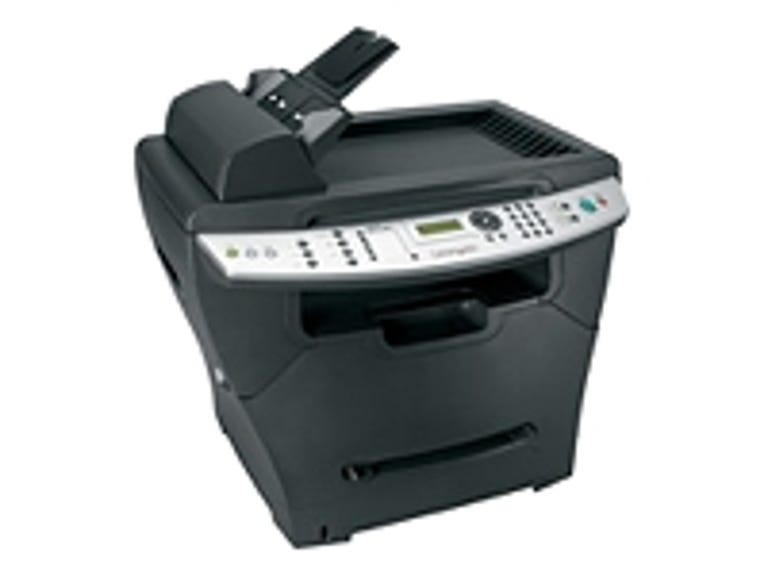 Why You Can Trust CNET
Why You Can Trust CNET Lexmark X340n review: Lexmark X340n
In a vacuum, the Lexmark X342n looks like a decent all-in-one monochrome laser printer for a small office environment, but ultimately, it loses out to the Dell 1815dn in terms of features and speed.
The Lexmark X342n's design screams "work." The gray unit stands 15.5 inches tall and has a footprint of about 14.5 inches wide by 13.5 inches deep, though the unit is wider on top than at the bottom. It weighs a reasonable 36 pounds, but we found it a bit difficult to move, as the handholds on the sides aren't deep enough to get a good grip. The scanner lid, with attached automatic document feeder, feels well-constructed, though light. The hinges of the lid lift out a bit to accommodate thicker materials but not enough to sit flat on really thick books. Unfortunately, neither the X340n nor the X342n have duplexing capability--not even as an add-on option. They are, however, network ready, with a built-in 10/100 Ethernet port.
The Good
The Bad
The Bottom Line
The control panel for the Lexmark X342n features a multitude of buttons, including ones to switch between functions, common options for each function, preset numbers for faxing and the standard numeric keypad, menu navigation buttons (up, down, select, back, and menu), and start and stop buttons. The two-line LCD is backlit for easy reading in dim light. Despite the wealth of buttons, the X342n's options are more limited than the Dell 1815dn's. A whirl through the menu shows a flaw that we found very frustrating: drilling down through the menu is simple enough, but when you make a change to a setting, you're automatically booted out of the menu, instead of returning to the previous level. If you want to make multiple changes at once, say, when you're setting up the printer for the first time, you'll have to hit the menu button for each change you want to make. If you drill down without making changes, though, there is a dedicated back button to help you back out of the menus.
The automatic document feeder atop the printer can handle 50 pages, while the standard paper drawer holds 250 sheets. The drawer slides out without any stops, so be careful not to pull too enthusiastically lest you drop the whole tray. You can purchase an optional 550-sheet input drawer for $200, bringing the printer's maximum input capacity to 800 sheets. The output tray is contained within the body of the printer and holds up to 150 pages; while the design is efficient, you can't expand the output capacity. The backward slant of the output tray makes it unlikely that your printed pages will spill out, and a small piece of plastic flips out to further ensure that longer pages don't go flying. A slot in the front serves as a manual, single-sheet feeder; the paper guides are adjustable but don't snap to standard page sizes. A rear panel in the back flips open to serve as an alternate output for thicker media, such as card stock.
Each function of the X342n can be customized to some extent. When copying, you can opt to fit multiple pages onto a single sheet by shrinking them; optimize the output by designating the original as text, photo, or mixed; and change the darkness of the output. We found an odd quirk when resizing pages for copying: the up button shrinks the page, while the down button blows it up--totally counterintuitive. As for scanning, the included software--Qlink, Presto Page Manager, and Abbyy--can help you. With Presto, you can convert file formats, initiate scans, and preview different file types. Abbyy lets you scan a document to an editable form, such as text or HTML. And Qlink lets you scan to a number of different programs, such as Office, PowerPoint, and Excel; Acrobat; and Microsoft Paint. Scan formats include PDF, TIFF, and JPEG. Unlike the Dell 1815dn, though, you can't scan to a flash thumbdrive, though. When it comes to faxing, the X342n again has fewer options than the Dell 1815dn. While you can perform standard tasks, such as broadcasting or delaying an outgoing fax, you can't set up a secure receive or forward incoming faxes to e-mail addresses or fax to e-mail addresses.
The Lexmark X342n was both better and worse than the Dell in overall performance. In our speed tests, it fell just behind the Dell 1815dn in every category except copying, where it excelled, spitting out 13.19 pages per minute (ppm) to the Dell's 12.29ppm. Like the Dell, the X342n printed black graphics a tad faster than it printed black text: 18.48ppm for the former and 17.13ppm for the latter.
Print quality, however, is a different story. At larger point sizes (about 6 points and larger), the Lexmark printed black text just fine: the letters were cleanly formed, and the color looked uniform. Smaller text, when looked at under a loupe, showed some problems. At very small point sizes, the letters looked spindly and unevenly spaced. Some letters looked thicker than others, indicating an unevenness in laying down toner.
The Lexmark also edged out the Dell in printing grayscale graphics: it handled both shadows and highlights better, preserving details that the Dell lost. Likewise, the Lexmark X342n handled scans better than the Dell did. In the grayscale scan test, the X342n again showed better handling of highlights and shadows than the Dell, which tended to lose detail on either end of the grayscale. The color scans also showed good detail, though the colors looked a bit washed-out.
(Longer bars indicate better performance)
| Copy | Grayscale scan | Color scan | Black graphics | Black text |
(Longer bars indicate better performance)
| Grayscale scan | Color scan | Graphics | Text |
